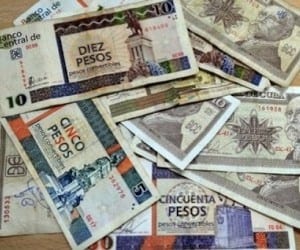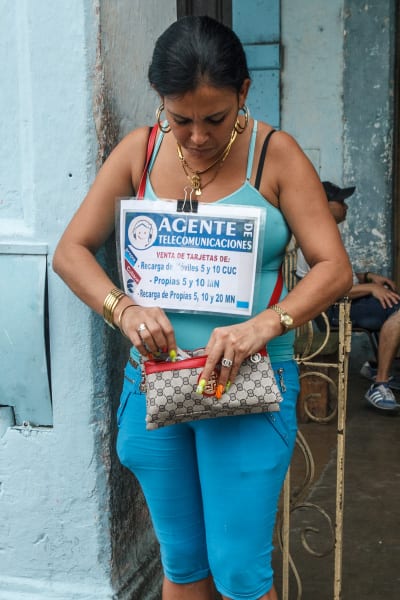Where Will Cubans Look to Now?
Cuba’s double currency is a “contradiction” which is widely accepted, but whose solution is still far off
By Alejandro Armengol (Cubaencuentro)

HAVANA TIMES — A schizophrenic situation has been enduring in Cuba for decades: the State sells things to you, but it doesn’t pay you enough to be able to buy them. With this attitude, which is parasitic to the extreme, the government continues to hold absolute control – political and economic – while feeding a nationalist rhetoric. More than a contradiction, it would make more sense to call it incoherence imposed forcefully.
There’s no hope that the discrepancy between prices and incomes will lessen at all, in fact it’s the complete opposite. By only seeing the issue as the result of a double currency, is to interpret a consequence of the problem to be its essence.
Cuba’s double currency is a “contradiction” which is widely accepted, but whose solution is still far off, to the point that today, it’s been completely set aside on the government’s agenda and isn’t even mentioned in government media.
Journalist Fernando Ravsberg quotes the economist Juan Triana, who claims that the unification of national currency could mean that over 60% of state companies will have to shut down, as they are currently benefitting from an artificial exchange rate.
When these companies need to import, the State recognizes the parity between the regular Cuban peso and the US dollar, while the real exchange rate is in actual fact 24 to 1.
If national currency and exchange rates were to be standardized, these companies would be unable to buy necessary supplies to continue producing, he explains.
According to Ravsberg in a recent article, Triana claims that the unification of exchange rates and the bankruptcy of state companies would end up destroying approximately 2 million jobs.

In order to prevent mass unemployment, the Cuban economy would have to diversify to a point that the country’s political hierarchy doesn’t allow. This was the path that has been interrupted since the very beginning, which Fidel Castro seemed to oppose – and everything seems to point to his ghost opposing this too – whose fears multiplied after Obama’s visit.
By placing hurdles and excessive obstacles in the private sector, which have prevented its widespread development; the agricultural sector’s failed development objectives to replace imports; plus plummeting prices on the global market for raw materials and the increasing crisis in Venezuela, the Cuban government is holding onto stagnation with more force than ever.
Cuba’s double currency problem sets an example of Cuba’s ruling elite’s determination, which seems to be for life, of prolonging the matter and moving it into some kind of limbo, which tries to hide their lack of ability or willingness to find a solution.
It is a strategy which has led to economic failure, which – at the same time and for decades now – has served as a political tactic. Likewise, it has achieved its goal up until now: to believe that this dead-end road is temporary.
Thereby repeating the paradox in the Cuban model, where the lack of productive efficiency has been the political system’s trump card on many occasions.
In the face of the increasing gap between wages and prices, the government is only looking abroad for the much needed funds to keep it afloat – remittances, tourism, medical services and professional services abroad and very specific exports, such as the pharmaceutical industry and some minerals – while it fails to understand the survival of its citizens.
However, due to a series of factors which weren’t necessarily meant to coincide, all of the above have come together in the kind of a perfect storm of distress, today, as Cubans see themselves experiencing a frightening drought on the island; less and less gasoline from Venezuela, and just how important this is for cars; and growing uncertainty as to whether the restrictions from the George W. Bush era will return and with the doors to the United States becoming more and more closed. Where will they look to now?






You say that having more than one currency “is rather normal”. Out of the over 200 countries in the world, please name five.
The economic model has been evolving for some time away from the primitive barter system of the Soviets. Because the regime refuses to deal with reality a secondary market has emerged that functions outside of the state regulations. It is controlled by intimidation versus legal rules to prevent it from getting to large. But it is how the place works as the central planner model can’t do it all. With some regulations and taxes this secondary market could be brought under state control. It just means that the government has to acknowledge it’s own system failed. No one likes taxes, but it turns out that a little socialism funded by taxes on market sector works a whole lot better than central planning. Social goods such as medical, education, housing assistance and so on work better with a money based economy. Lot’s of examples of those types of economies, not many based on the old failed Soviet model.
It’s taken the Castro family regime fifty eight years to get to the current economic level of achievement. The regime according to Fidel, Raul and the PCC has been fulfilling its goals and achievements – standard of living for Cubans doesn’t change – but it doesn’t matter to the regime. Can anyone remember when the Poder Popular addressed improving living standards in Cuba? Can anyone remember when the Executive Council of Ministers last addressed improving the living standards of Cubans?
This is an opportunity to speak up and give the dates!
It’s time for Cuba to push the reset button, almost everything must change or your standard of living will go lower then it is now. Cuba can not keep up the business as usuall any longer, large changes are now needed to reverse your downward spiral
World events during the last two years have led to most currencies falling against the US dollar. If Ms. Yellen permits any increase in interest rates in the US, that difference will be exacerbated. The Cuban convertible is at a fixed rate of equaling one US dollar and not being an international currency is unaffected by international money markets.
Much of Cuba’s hard currency comes from tourism where US tourists represent only a small percentage – Canada represents over 40%. But the Canadian dollar which under a previous government acually hit par with the US dollar, is now at 73 cents and the Euro is similarly affected.
There is an obvious probability of Canadian tourists in particular changing their bookings to Mexico where Cancun offers similar conditions to Varadero. The Castro regime looks hopefully at the US wishing for a very substantial increase in tourists from there, but that anticipates a change in US policies. Cuba should reflect upon a bird in the hand being worth two in the bush.
The change away from the dry foot policy will reduce the number of Cubans entering the US annually (46,000 in 2016). which in turn will tend to inhibit any increase in remittances. It is four years since the regime announced that it was going to revert to a single currency – but that was when Marino Murillo was economic Tzar and he has been fired. There is a deep fear of inflation and the regime cannot allow the CUC to float.
What actually happens is very much dependent upon GAESA the military holding company which controls over 80% of the economy. GAESA is the importer and operates all the retail outlets – Pan Americana, TRD, CIMEX et all and much of the tourism sector – hotels, transport (Transtur, Gaviota, CubaCar etc.) The huge mark-ups which it imposes anticipate that most of those remittances will end up in the GAESA pockets. GAESA retail prices have not declined although many of the products being sold are being purchased for less as currencies fall against the US dollar, indeed the reverse is the case.
The regime is unconcerned about the living standards of the citizens of Cuba. They are the much desired “mass” expected to comply with the dictates of the regime. When did the Poder Popular last discuss how to improve the living standards of Cubans? Chinese credit is enabling survival and has replaced the Venezuelan support.
The difficulties faced by Cuba can only be resolved by adoption of capitalism as demonstrated by China and Vietnam. But the Castro regime is embedded in the 19th century thinking of Marx and as Fidel Castro added to the Constitution in 2002 – “Socialism is permanent and irrevocable.” Cubans pay the price in their daily lives – trying to exist!
Having more than one currency is rather normal. The only odd thing might be that they come from the same body. When I “left” I had to pay over 120 pesos per dollar so somehow they have managed to go up ~200 % without being able to legally be part of any meaningful form of trade.